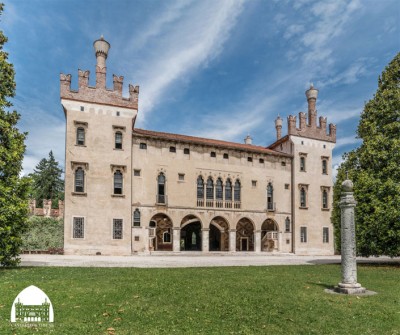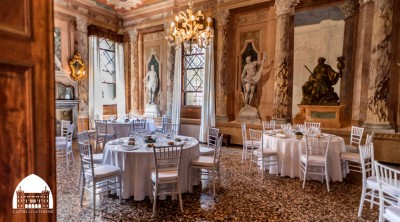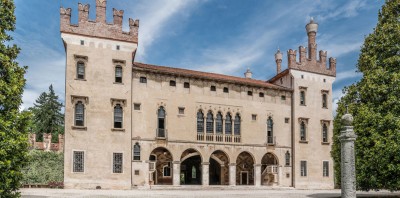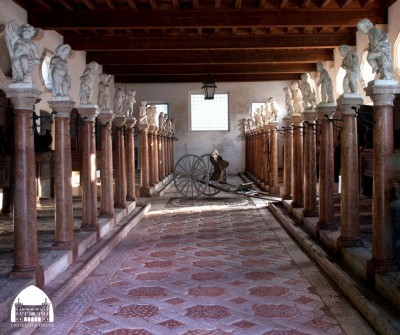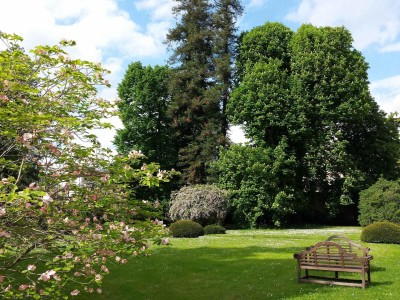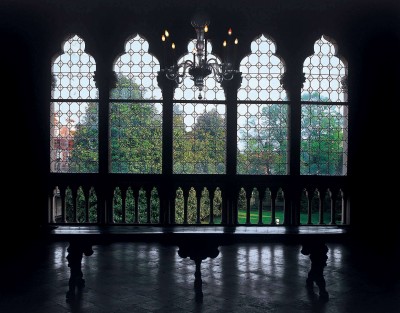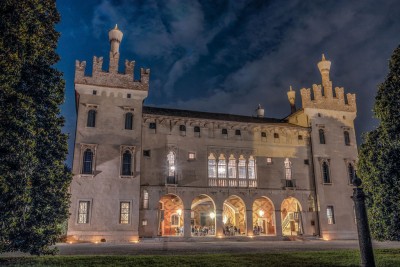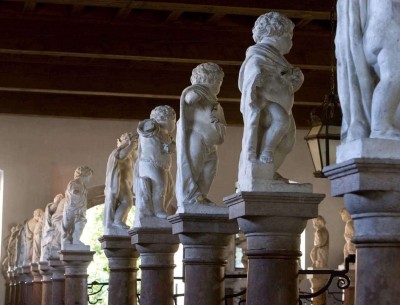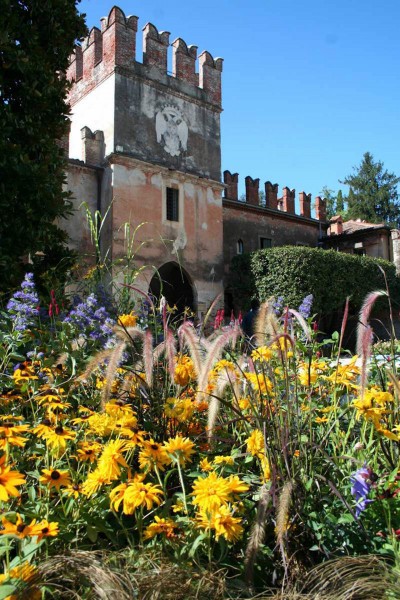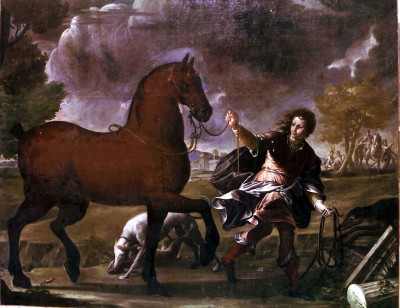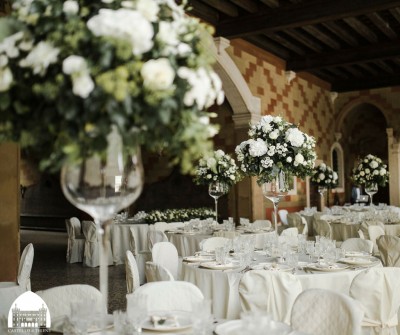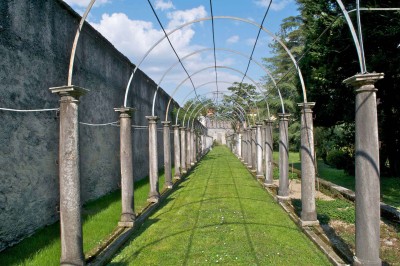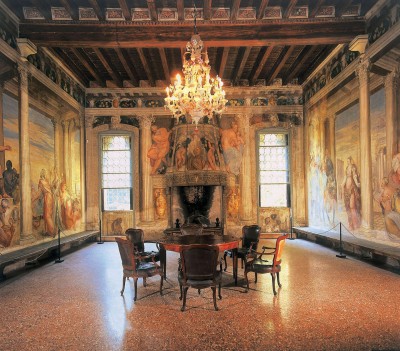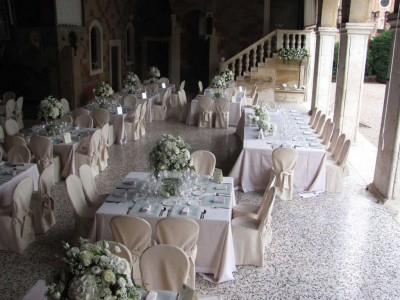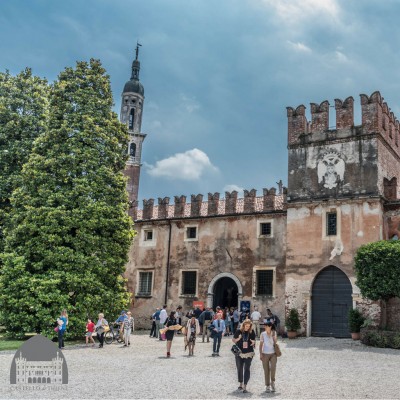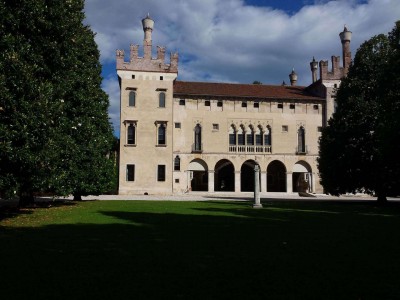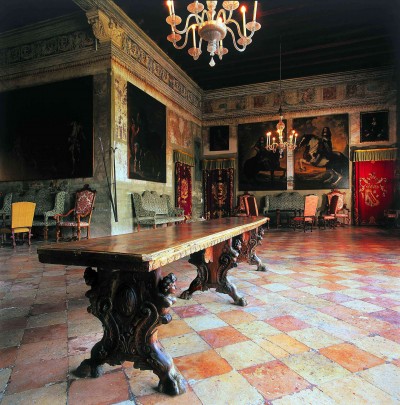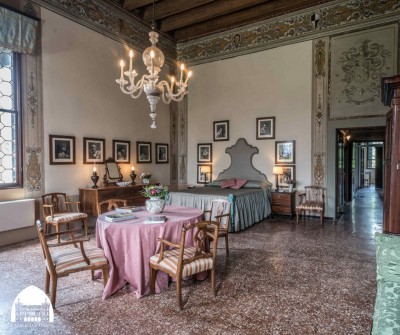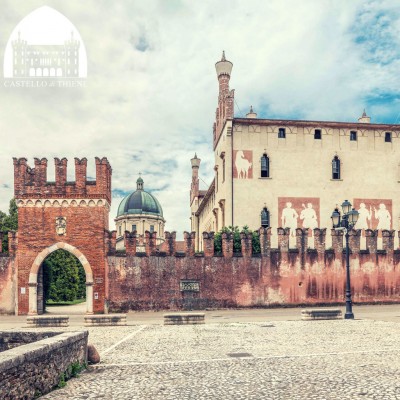Thiene Castle is the ideal place to hold receptions, conferences, company meetings, exhibitions of various kind, concerts, art exhibitions, photographic and television advertisement shoots. Live also the dream of sleeping in an ancient and prestigious castle.
Contact the abode
CASTELLO DI THIENE
The Castle of Thiene, also known as Porto Colleoni Castle, is one of the most exclusive locations in the Veneto area for the organisation of special events. It is also possible to experience life in the Castle by staying overnight.
The estate is a 15th-century building near Vicenza that was initially built for civil use. It is considered to be a unique example of its kind and a benchmark in the evolution of the Veneto villa, as it successfully combines the attributes of a castle with those of a Venetian palazzo, and in particular what used to be called a 'casa-fondaco': both residence and warehouse cum trading place.
The layout of the castle at the centre of the three storeys is T-shaped. The main body has a large loggia, which opens onto the front with five wide arches. The first floor has a corresponding to a Gothic ‘pentafora’ window, which is divided into five vertical openings by four small columns or pilasters and is the only example of its kind outside of Venice. The building is possibly attributed to the great architect Domenico da Venezia, 'engineer' of the city of Vicenza. While there are no formal documents attesting to it, the design is probably attributable to the prominent architect Domenico da Venezia, considered an 'engineer' of the city of Vicenza.
The many halls and reception rooms are still perfectly furnished and feature an extensive collection of period portraits; of particular note is the cycle of frescoes by G. Battista Zelotti and G. Antonio Fasolo, who were two of the most important pupils of Paolo Veronese, depicting scenes of Roman history narrated by Tito Livio.
The 'private' rooms, which can be visited on request, contain objects of everyday use including clothing and various accessories. There is an unusual collection of equestrian portraits in the Horse Gallery, and the stables, designed by architect Francesco Muttoni in the early 18th century, are truly exceptional. The large noble courtyard at the front of the Castle features ‘barchesse’ arcades and centuries-old magnolia trees. At the rear of the building, there is an extensive park containing a cedar grove, an artificial canal and a grotto.
The Castle is the private residence of the Thiene Counts, who reside on the property and who passionately preserve and promote the vast estate by hosting major cultural events and offering guided tours for visitors to the area. It is now also possible to enjoy an unforgettable holiday and sleep inside the Castle itself. The Castle is completely enclosed and is located in the heart of Thiene's historian centre, in front of the Town Hall.
THE HISTORY OF CASTELLO DI THIENE
In 1441, Francesco Porto Senior inherited a large property holding from his father and uncle, which was principally concentrated in Thiene, Marano and Malo, where the Porto family had already purchased a considerable amount of land in the 14th century. He subsequently began construction work on the building in around 1450.
Francesco Porto Junior (1472-1554, grandson of the founder) commissioned extension works (such as the raising of the granary level), an embellishment of the garden with a maze, fountain and statues (of which the only trace that remains is in the archives), the construction of stone staircases and decoration of the facades (in the Venetian tradition) with imposing horses and medallions featuring Roman emperors.
Francesco was nominated Generale Collaterale by Doge Gritti (1532), a position entrusted only to people of proven loyalty, and given administrative responsibilities for recruiting troops, supervising their quartering and providing for their payment.
Francesco is fundamental in the history of the castle: in 1541 he set up a trust in which - having no sons - he nominated the first-born male in the descending lines of his brothers to inherit the Palazzo and non-transferable ownership of the ‘Thiene’ assets gained by their succession.
The overall Renaissance transformation project was initiated by his grandson Giovanni (the first heir in the hierarchy), beginning with the well created by Palladio (1554) and the frescoes in the Fireplace Room (c. 1570), and completed by Giovanni Battista (Giovanni’s only son), who built the citrus winter garden and the grotto with its fishpond in the garden (1580), realised by Cristoforo Sorte.
The stables were built at the start of the 18th century to a design by Francesco Muttoni in association with the renowned Marinali sculpture workshop in what is a rare example of magnificence and rationale.
At the end of the 18th century, the left wing of the portico on the ground floor was altered. It had previously contained the service rooms (kitchen, laundry, oven etc.) connected to the ‘fattoria’ farmstead where the administrative functions of the property used to be carried out: the dividing walls were demolished and two reception rooms were created, one of which was frescoed with ‘The Fall of Phaeton’.
Orazio Porto (1729-1816) nominated his great grandson Orazio Guardino Colleoni as his heir, with the provision that he live in Vicenza and add the Porto surname to his own. The castle remained under the ownership of the Colleoni-Porto family for three generations. An initial period of disinterest was followed by a vast programme to renovate the furnishings and transform the gardens. Guardino, the last of the line, died childless in 1918 and named his cousin Antonio Thiene as his heir.
The original layout has been altered over more than 500 years of conversions, adjustments, extensions and maintenance, creating a very interesting and constantly evolving layering of functions, materials, furnishings and decorations, still far from being exhaustively explored.
The Castle, which has become the symbol of Thiene, remains a private residence lovingly preserved by its current owners, the Conti di Thiene, who are committed to constantly promoting and developing this vast monumental complex to ensure it can always be enjoyed by scholars, visitors and those who are simply curious.
FACILITIES AND SERVICES: WEDDINGS AND PRIVATE EVENTS IN THE VENETO REGION
Prezzi per eventi: da € 2.500 a € 3.000 + iva Prezzi per matrimoni: da € 2.000 a € 3.000 + iva Prezzi visite: Singoli: € 10,00 Gruppi: € 8,00 se più di 20 persone Studenti in comitiva e ragazzi 12-18 anni: € 6,00 Studenti universitari: € 8,00 Pacchetto famiglia 1 (genitori + 1 figlio 12-18 anni): € 25,00 Pacchetti famiglia 2 (genitori + 2 figli 12-18 anni): € 28,00 Accesso gratuito per i bambini sotto i 12 anni Le tariffe indicate sono comprensive del servizio guida e la visita dura circa 50 minuti Sempre con nostra guida interna, solo previo accordo telefonico è possibile scegliere di visitare anche: - Le camere da letto: € 2,00 a persona (durata: 20') - Le sale di rappresentanza ala ovest e cucina: € 2,00 a persona (durata 15') - Il parco e la ghiacciaia: € 2,00 a persona (durata 20')
EVENTS AT THIENE CASTLE
Market Fairs are held twice a year in April and November, celebrating the excellence of Italian craftsmanship. "Tempo di Primavera" in springtime and "Tempo di Natale" at Christmastime are both held inside the Castle.
PLACES OF INTEREST IN THE VICINITY
Thiene is located between the provinces of Vicenza (20km), Padua (60km), Verona (75km) and Venice (80km). Lake Garda is 100km away, spa areas such as Abano are 50km’s drive from the Castle.
Places to visit nearby include: Asiago, Marostica, Bassano, Asolo, Vicenza, Villa Caldogno (Caldogno), Villa Godi Malinverni (Lugo), Villa da Schio (Castelgomberto), Villa Trissino Marzotto (Trissino), Villa Valmarana ai Nani (Vicenza).
